
Illustrative Math Alignment: Grade 6 Unit 1
Arithmetic in Base Ten
Lesson 6: Methods for Multiplying Decimals
Use the following Media4Math resources with this Illustrative Math lesson.
| Thumbnail | Title | Description | Curriculum Nodes |
|---|---|---|---|
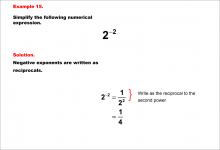
|
Math Example--Exponential Concepts--Integer and Rational Exponents--Example 15 | Math Example--Exponential Concepts--Integer and Rational Exponents--Example 15TopicExponents DescriptionExample 15 shows how to simplify 2-2. The image illustrates rewriting 2-2 as the reciprocal of 2 raised to the second power. Example 15: Simplify 2-2. Negative exponents are written as reciprocals. Solution: 2-2 = 1/(22) = 1/4. |
Numerical Expressions |
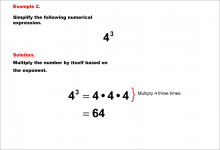
|
Math Example--Exponential Concepts--Integer and Rational Exponents--Example 2 | Math Example--Exponential Concepts--Integer and Rational Exponents--Example 2TopicExponents DescriptionShows Example 2 with the expression 43. The solution explains the simplification by multiplying 4 three times. Example 2: Simplify 43. Multiply 4 by itself three times: 4•4•4 = 64. In general, the topic of exponents involves understanding how repeated multiplication can be expressed more compactly. The examples provided in this collection allow students to see the step-by-step breakdown of how to simplify various exponential expressions, which can include positive and negative bases, fractional bases, and negative exponents. |
Numerical Expressions |

|
Math Example--Exponential Concepts--Integer and Rational Exponents--Example 2 | Math Example--Exponential Concepts--Integer and Rational Exponents--Example 2TopicExponents DescriptionShows Example 2 with the expression 43. The solution explains the simplification by multiplying 4 three times. Example 2: Simplify 43. Multiply 4 by itself three times: 4•4•4 = 64. In general, the topic of exponents involves understanding how repeated multiplication can be expressed more compactly. The examples provided in this collection allow students to see the step-by-step breakdown of how to simplify various exponential expressions, which can include positive and negative bases, fractional bases, and negative exponents. |
Numerical Expressions |

|
Math Example--Exponential Concepts--Integer and Rational Exponents--Example 2 | Math Example--Exponential Concepts--Integer and Rational Exponents--Example 2TopicExponents DescriptionShows Example 2 with the expression 43. The solution explains the simplification by multiplying 4 three times. Example 2: Simplify 43. Multiply 4 by itself three times: 4•4•4 = 64. In general, the topic of exponents involves understanding how repeated multiplication can be expressed more compactly. The examples provided in this collection allow students to see the step-by-step breakdown of how to simplify various exponential expressions, which can include positive and negative bases, fractional bases, and negative exponents. |
Numerical Expressions |
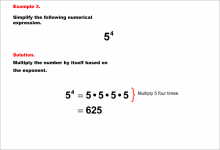
|
Math Example--Exponential Concepts--Integer and Rational Exponents--Example 3 | Math Example--Exponential Concepts--Integer and Rational Exponents--Example 3TopicExponents DescriptionShows Example 3 with the expression 54. The solution details multiplying 5 four times. Example 3: Simplify 54. Multiply 5 by itself four times: 5•5•5•5 = 625. In general, the topic of exponents involves understanding how repeated multiplication can be expressed more compactly. The examples provided in this collection allow students to see the step-by-step breakdown of how to simplify various exponential expressions, which can include positive and negative bases, fractional bases, and negative exponents. |
Numerical Expressions |

|
Math Example--Exponential Concepts--Integer and Rational Exponents--Example 3 | Math Example--Exponential Concepts--Integer and Rational Exponents--Example 3TopicExponents DescriptionShows Example 3 with the expression 54. The solution details multiplying 5 four times. Example 3: Simplify 54. Multiply 5 by itself four times: 5•5•5•5 = 625. In general, the topic of exponents involves understanding how repeated multiplication can be expressed more compactly. The examples provided in this collection allow students to see the step-by-step breakdown of how to simplify various exponential expressions, which can include positive and negative bases, fractional bases, and negative exponents. |
Numerical Expressions |

|
Math Example--Exponential Concepts--Integer and Rational Exponents--Example 3 | Math Example--Exponential Concepts--Integer and Rational Exponents--Example 3TopicExponents DescriptionShows Example 3 with the expression 54. The solution details multiplying 5 four times. Example 3: Simplify 54. Multiply 5 by itself four times: 5•5•5•5 = 625. In general, the topic of exponents involves understanding how repeated multiplication can be expressed more compactly. The examples provided in this collection allow students to see the step-by-step breakdown of how to simplify various exponential expressions, which can include positive and negative bases, fractional bases, and negative exponents. |
Numerical Expressions |
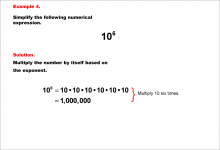
|
Math Example--Exponential Concepts--Integer and Rational Exponents--Example 4 | Math Example--Exponential Concepts--Integer and Rational Exponents--Example 4TopicExponents DescriptionShows Example 4 with the expression 106. The solution simplifies by multiplying 10 six times. Example 4: Simplify 106. Multiply 10 by itself six times: 10•10•10•10•10•10 = 1,000,000. |
Numerical Expressions |

|
Math Example--Exponential Concepts--Integer and Rational Exponents--Example 4 | Math Example--Exponential Concepts--Integer and Rational Exponents--Example 4TopicExponents DescriptionShows Example 4 with the expression 106. The solution simplifies by multiplying 10 six times. Example 4: Simplify 106. Multiply 10 by itself six times: 10•10•10•10•10•10 = 1,000,000. |
Numerical Expressions |

|
Math Example--Exponential Concepts--Integer and Rational Exponents--Example 4 | Math Example--Exponential Concepts--Integer and Rational Exponents--Example 4TopicExponents DescriptionShows Example 4 with the expression 106. The solution simplifies by multiplying 10 six times. Example 4: Simplify 106. Multiply 10 by itself six times: 10•10•10•10•10•10 = 1,000,000. |
Numerical Expressions |
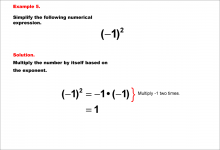
|
Math Example--Exponential Concepts--Integer and Rational Exponents--Example 5 | Math Example--Exponential Concepts--Integer and Rational Exponents--Example 5TopicExponents DescriptionShows Example 5 with the expression (-1)2. The solution explains the result by multiplying -1 by itself. Example 5: Simplify (-1)2. Multiply -1 by itself two times: (-1)•(-1) = 1. |
Numerical Expressions |

|
Math Example--Exponential Concepts--Integer and Rational Exponents--Example 5 | Math Example--Exponential Concepts--Integer and Rational Exponents--Example 5TopicExponents DescriptionShows Example 5 with the expression (-1)2. The solution explains the result by multiplying -1 by itself. Example 5: Simplify (-1)2. Multiply -1 by itself two times: (-1)•(-1) = 1. |
Numerical Expressions |

|
Math Example--Exponential Concepts--Integer and Rational Exponents--Example 5 | Math Example--Exponential Concepts--Integer and Rational Exponents--Example 5TopicExponents DescriptionShows Example 5 with the expression (-1)2. The solution explains the result by multiplying -1 by itself. Example 5: Simplify (-1)2. Multiply -1 by itself two times: (-1)•(-1) = 1. |
Numerical Expressions |
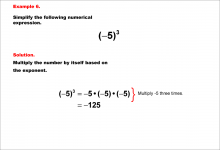
|
Math Example--Exponential Concepts--Integer and Rational Exponents--Example 6 | Math Example--Exponential Concepts--Integer and Rational Exponents--Example 6TopicExponents DescriptionShows Example 6 with the expression (-5)3. The solution demonstrates multiplying -5 three times. Example 6: Simplify (_5)3. Multiply -5 by itself three times: (-5)•(-5)•(-5) = -125. |
Numerical Expressions |

|
Math Example--Exponential Concepts--Integer and Rational Exponents--Example 6 | Math Example--Exponential Concepts--Integer and Rational Exponents--Example 6TopicExponents DescriptionShows Example 6 with the expression (-5)3. The solution demonstrates multiplying -5 three times. Example 6: Simplify (_5)3. Multiply -5 by itself three times: (-5)•(-5)•(-5) = -125. |
Numerical Expressions |

|
Math Example--Exponential Concepts--Integer and Rational Exponents--Example 6 | Math Example--Exponential Concepts--Integer and Rational Exponents--Example 6TopicExponents DescriptionShows Example 6 with the expression (-5)3. The solution demonstrates multiplying -5 three times. Example 6: Simplify (_5)3. Multiply -5 by itself three times: (-5)•(-5)•(-5) = -125. |
Numerical Expressions |

|
Math Example--Exponential Concepts--Integer and Rational Exponents--Example 7 | Math Example--Exponential Concepts--Integer and Rational Exponents--Example 7TopicExponents DescriptionShows Example 7 with the expression (-6)4. The solution explains multiplying -6 by itself four times. Example 7: Simplify (-6)4. Multiply -6 by itself four times: (-6)•(-6)•(-6)•(-6) = 1296. |
Numerical Expressions |

|
Math Example--Exponential Concepts--Integer and Rational Exponents--Example 7 | Math Example--Exponential Concepts--Integer and Rational Exponents--Example 7TopicExponents DescriptionShows Example 7 with the expression (-6)4. The solution explains multiplying -6 by itself four times. Example 7: Simplify (-6)4. Multiply -6 by itself four times: (-6)•(-6)•(-6)•(-6) = 1296. |
Numerical Expressions |

|
Math Example--Exponential Concepts--Integer and Rational Exponents--Example 7 | Math Example--Exponential Concepts--Integer and Rational Exponents--Example 7TopicExponents DescriptionShows Example 7 with the expression (-6)4. The solution explains multiplying -6 by itself four times. Example 7: Simplify (-6)4. Multiply -6 by itself four times: (-6)•(-6)•(-6)•(-6) = 1296. |
Numerical Expressions |
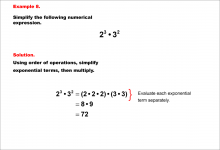
|
Math Example--Exponential Concepts--Integer and Rational Exponents--Example 8 | Math Example--Exponential Concepts--Integer and Rational Exponents--Example 8TopicExponents DescriptionShows Example 8 with the expression 23•32. The solution demonstrates using order of operations to simplify each term separately, then multiply. Example 8: Simplify 23•32. Evaluate each exponential term separately, then multiply: 8•9 = 72. |
Numerical Expressions |

|
Math Example--Exponential Concepts--Integer and Rational Exponents--Example 8 | Math Example--Exponential Concepts--Integer and Rational Exponents--Example 8TopicExponents DescriptionShows Example 8 with the expression 23•32. The solution demonstrates using order of operations to simplify each term separately, then multiply. Example 8: Simplify 23•32. Evaluate each exponential term separately, then multiply: 8•9 = 72. |
Numerical Expressions |

|
Math Example--Exponential Concepts--Integer and Rational Exponents--Example 8 | Math Example--Exponential Concepts--Integer and Rational Exponents--Example 8TopicExponents DescriptionShows Example 8 with the expression 23•32. The solution demonstrates using order of operations to simplify each term separately, then multiply. Example 8: Simplify 23•32. Evaluate each exponential term separately, then multiply: 8•9 = 72. |
Numerical Expressions |
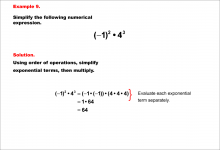
|
Math Example--Exponential Concepts--Integer and Rational Exponents--Example 9 | Math Example--Exponential Concepts--Integer and Rational Exponents--Example 9TopicExponents DescriptionShows Example 9 with the expression (-1)2•43. The solution explains simplifying each term individually before multiplying. Example 9: Simplify (-1)2•43. Evaluate each exponential term separately, then multiply: 1•64 = 64. |
Numerical Expressions |

|
Math Example--Exponential Concepts--Integer and Rational Exponents--Example 9 | Math Example--Exponential Concepts--Integer and Rational Exponents--Example 9TopicExponents DescriptionShows Example 9 with the expression (-1)2•43. The solution explains simplifying each term individually before multiplying. Example 9: Simplify (-1)2•43. Evaluate each exponential term separately, then multiply: 1•64 = 64. |
Numerical Expressions |

|
Math Example--Exponential Concepts--Integer and Rational Exponents--Example 9 | Math Example--Exponential Concepts--Integer and Rational Exponents--Example 9TopicExponents DescriptionShows Example 9 with the expression (-1)2•43. The solution explains simplifying each term individually before multiplying. Example 9: Simplify (-1)2•43. Evaluate each exponential term separately, then multiply: 1•64 = 64. |
Numerical Expressions |
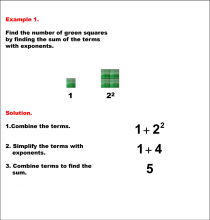
|
Math Example--Exponential Concepts--Modeling Sums with Integer Exponents--Example 1 | Math Example--Exponential Concepts--Modeling Sums with Integer Exponents--Example 1
This is part of a collection of math examples that focus on exponents, exponential expressions, and exponential functions. |
Numerical Expressions |

|
Math Example--Exponential Concepts--Modeling Sums with Integer Exponents--Example 1 | Math Example--Exponential Concepts--Modeling Sums with Integer Exponents--Example 1
This is part of a collection of math examples that focus on exponents, exponential expressions, and exponential functions. |
Numerical Expressions |
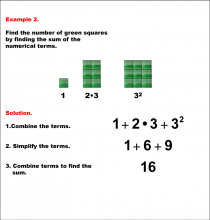
|
Math Example--Exponential Concepts--Modeling Sums with Integer Exponents--Example 2 | Math Example--Exponential Concepts--Modeling Sums with Integer Exponents--Example 2
This is part of a collection of math examples that focus on exponents, exponential expressions, and exponential functions. |
Numerical Expressions |

|
Math Example--Exponential Concepts--Modeling Sums with Integer Exponents--Example 2 | Math Example--Exponential Concepts--Modeling Sums with Integer Exponents--Example 2
This is part of a collection of math examples that focus on exponents, exponential expressions, and exponential functions. |
Numerical Expressions |

|
Math Example--Exponential Concepts--Modeling Sums with Integer Exponents--Example 3 | Math Example--Exponential Concepts--Modeling Sums with Integer Exponents--Example 3
This is part of a collection of math examples that focus on exponents, exponential expressions, and exponential functions. |
Numerical Expressions |

|
Math Example--Exponential Concepts--Modeling Sums with Integer Exponents--Example 3 | Math Example--Exponential Concepts--Modeling Sums with Integer Exponents--Example 3
This is part of a collection of math examples that focus on exponents, exponential expressions, and exponential functions. |
Numerical Expressions |
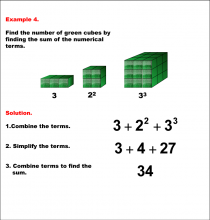
|
Math Example--Exponential Concepts--Modeling Sums with Integer Exponents--Example 4 | Math Example--Exponential Concepts--Modeling Sums with Integer Exponents--Example 4
This is part of a collection of math examples that focus on exponents, exponential expressions, and exponential functions. |
Numerical Expressions |

|
Math Example--Exponential Concepts--Modeling Sums with Integer Exponents--Example 4 | Math Example--Exponential Concepts--Modeling Sums with Integer Exponents--Example 4
This is part of a collection of math examples that focus on exponents, exponential expressions, and exponential functions. |
Numerical Expressions |
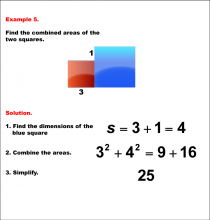
|
Math Example--Exponential Concepts--Modeling Sums with Integer Exponents--Example 5 | Math Example--Exponential Concepts--Modeling Sums with Integer Exponents--Example 5
This is part of a collection of math examples that focus on exponents, exponential expressions, and exponential functions. |
Numerical Expressions |

|
Math Example--Exponential Concepts--Modeling Sums with Integer Exponents--Example 5 | Math Example--Exponential Concepts--Modeling Sums with Integer Exponents--Example 5
This is part of a collection of math examples that focus on exponents, exponential expressions, and exponential functions. |
Numerical Expressions |
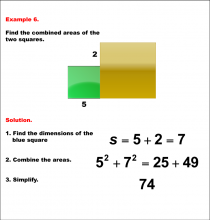
|
Math Example--Exponential Concepts--Modeling Sums with Integer Exponents--Example 6 | Math Example--Exponential Concepts--Modeling Sums with Integer Exponents--Example 6
This is part of a collection of math examples that focus on exponents, exponential expressions, and exponential functions. |
Numerical Expressions |

|
Math Example--Exponential Concepts--Modeling Sums with Integer Exponents--Example 6 | Math Example--Exponential Concepts--Modeling Sums with Integer Exponents--Example 6
This is part of a collection of math examples that focus on exponents, exponential expressions, and exponential functions. |
Numerical Expressions |
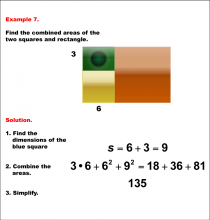
|
Math Example--Exponential Concepts--Modeling Sums with Integer Exponents--Example 7 | Math Example--Exponential Concepts--Modeling Sums with Integer Exponents--Example 7
This is part of a collection of math examples that focus on exponents, exponential expressions, and exponential functions. |
Numerical Expressions |

|
Math Example--Exponential Concepts--Modeling Sums with Integer Exponents--Example 7 | Math Example--Exponential Concepts--Modeling Sums with Integer Exponents--Example 7
This is part of a collection of math examples that focus on exponents, exponential expressions, and exponential functions. |
Numerical Expressions |
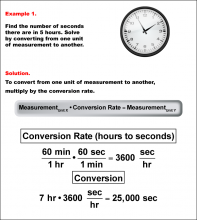
|
Math Example--Measurement--Converting Units--Example 1 | Math Example--Measurement--Converting Units--Example 1
This is part of a collection of math examples that focus on measurement. |
Numerical Expressions and Units of Measure |

|
Math Example--Measurement--Converting Units--Example 1 | Math Example--Measurement--Converting Units--Example 1
This is part of a collection of math examples that focus on measurement. |
Numerical Expressions and Units of Measure |

|
Math Example--Measurement--Converting Units--Example 10 | Math Example--Measurement--Converting Units--Example 10
This is part of a collection of math examples that focus on measurement. |
Numerical Expressions and Units of Measure |

|
Math Example--Measurement--Converting Units--Example 10 | Math Example--Measurement--Converting Units--Example 10
This is part of a collection of math examples that focus on measurement. |
Numerical Expressions and Units of Measure |
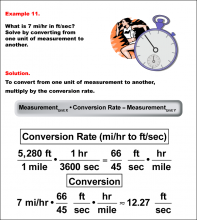
|
Math Example--Measurement--Converting Units--Example 11 | Math Example--Measurement--Converting Units--Example 11
This is part of a collection of math examples that focus on measurement. |
Numerical Expressions and Units of Measure |

|
Math Example--Measurement--Converting Units--Example 11 | Math Example--Measurement--Converting Units--Example 11
This is part of a collection of math examples that focus on measurement. |
Numerical Expressions and Units of Measure |
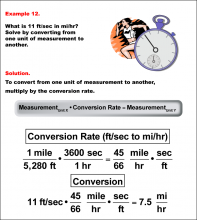
|
Math Example--Measurement--Converting Units--Example 12 | Math Example--Measurement--Converting Units--Example 12
This is part of a collection of math examples that focus on measurement. |
Numerical Expressions and Units of Measure |

|
Math Example--Measurement--Converting Units--Example 12 | Math Example--Measurement--Converting Units--Example 12
This is part of a collection of math examples that focus on measurement. |
Numerical Expressions and Units of Measure |
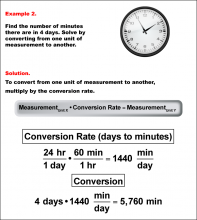
|
Math Example--Measurement--Converting Units--Example 2 | Math Example--Measurement--Converting Units--Example 2
This is part of a collection of math examples that focus on measurement. |
Numerical Expressions and Units of Measure |

|
Math Example--Measurement--Converting Units--Example 2 | Math Example--Measurement--Converting Units--Example 2
This is part of a collection of math examples that focus on measurement. |
Numerical Expressions and Units of Measure |

|
Math Example--Measurement--Converting Units--Example 4 | Math Example--Measurement--Converting Units--Example 4
This is part of a collection of math examples that focus on measurement. |
Numerical Expressions and Units of Measure |